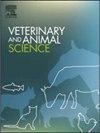Global distribution and host range of enzootic bovine leukosis in ruminants: A systematic review and meta-analysis
IF 1.9
Q2 AGRICULTURE, DAIRY & ANIMAL SCIENCE
引用次数: 0
Abstract
Enzootic bovine leukosis (EBL) causes severe economic losses and is a contagious disease caused by the Bovine Leukemia Virus (BLV), belonging to the delta retrovirus of the Retroviridae family. Thus, this review aimed to estimate the global pooled prevalence of enzootic bovine leukosis and investigate its host range, focusing on cattle and sheep. We used seven databases which include PubMed, Science Direct, HINARI, Scopus, Google Scholar, Web of Science, and AJOL. The included studies (50 articles), conducted between 1992 and 2024, represent diverse geographic regions: Asia, North America, Africa, South America, and Europe. 346,917 animals were involved, of which 99,620 involved positive for BLV. The meta-analysis estimated a pooled BLV prevalence of 19% (95% CI: 16%–23%) using random effect model, though significant heterogeneity existed across studies (I² = 99.6%, p < 0.001). Subgroup analysis revealed that the highest prevalence of EBL was in North America (43%), followed by Asia (17%), Africa (14%), South America (10%), and the lowest in Europe (4%). Analysis by publication year revealed that the prevalence of EBL was 32% after 2016, whereas it was 29% before 2016. Among animal species, beef cattle exhibited the highest prevalence (26%), followed by overall cattle (20%), sheep (19%), and dairy cattle (18%). Geographical and temporal trends revealed varying prevalence rates, with notable high rates in North America and lower rates in regions such as Europe. It is crucial that North America adopt stricter prevention programs, similar to those in Europe, to reduce transmission of EBL and its economic and health impacts on livestock.
反刍动物地方性牛白血病的全球分布和宿主范围:系统综述和荟萃分析
牛流行性白血病(EBL)是由牛白血病病毒(BLV)引起的一种传染性疾病,是逆转录病毒科的delta型逆转录病毒。因此,本综述旨在估计全球牛地方性白血病的总流行率,并调查其宿主范围,重点是牛和羊。我们使用了PubMed、Science Direct、HINARI、Scopus、b谷歌Scholar、Web of Science和AJOL等7个数据库。纳入的研究(50篇文章)在1992年至2024年间进行,代表了不同的地理区域:亚洲、北美、非洲、南美和欧洲,涉及346,917只动物,其中99,620只动物BLV阳性。meta分析使用随机效应模型估计合并BLV患病率为19% (95% CI: 16%-23%),尽管各研究之间存在显著的异质性(I²= 99.6%,p < 0.001)。亚组分析显示,EBL患病率最高的是北美(43%),其次是亚洲(17%)、非洲(14%)、南美(10%),最低的是欧洲(4%)。按出版年份分析显示,2016年之后EBL的患病率为32%,而2016年之前为29%。在动物种类中,肉牛患病率最高(26%),其次是全牛(20%)、绵羊(19%)和奶牛(18%)。地理和时间趋势揭示了不同的流行率,北美的流行率明显高,而欧洲等区域的流行率较低。至关重要的是,北美应采取与欧洲类似的更严格的预防规划,以减少EBL的传播及其对牲畜的经济和健康影响。
本文章由计算机程序翻译,如有差异,请以英文原文为准。
求助全文
约1分钟内获得全文
求助全文
来源期刊

Veterinary and Animal Science
Veterinary-Veterinary (all)
CiteScore
3.50
自引率
0.00%
发文量
43
审稿时长
47 days
 求助内容:
求助内容: 应助结果提醒方式:
应助结果提醒方式:


